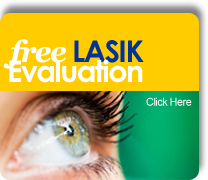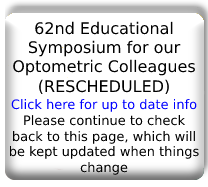Crystalens - Interocular Lens
Anatomy/Conditions of the Eye
Understanding Cataracts
A Natural Effect Of Aging
The eye's natural crystalline lens helps us focus on people and things at varying distances. Unfortunately, as we grow older this lens often stiffens and hardens, and without its youthful suppleness, it loses its ability to focus, creating vision problems. This condition - for most, a natural consequence of aging - is called presbyopia. Some people begin experiencing the early effects of presbyopia (such as gradual loss of near vision) in their mid-40s.
As we age, these changes occurring to the natural crystalline lens can lead to the development of cataracts. By age 65, a large percentage of us will develop a cataract, most often typified by cloudy/fuzzy vision. With a cataract you may have difficulty seeing in extremely bright light or low lighted conditions.
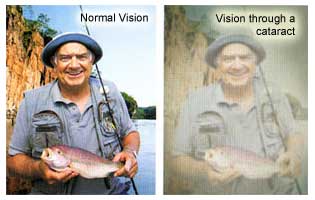
Improving Your Vision
Developing a cataract doesn't mean a permanent loss of vision quality, or having to give up the things you love, because cataract surgery is a safe, effective way to improve your vision. Cataract surgery is the most commonly performed surgery in the United States, with well over 2 million Americans having the procedure every year. Performed almost exclusively on an outpatient basis, cataract surgery is microsurgery, whereby the natural lens is removed and replaced with what is called an intraocular lens (IOL). The procedure is highly successful and most people regain very good distance vision, somewhere between 20/20 and 20/40.
An Important Choice
During cataract surgery, your physician will replace your natural lens with an IOL. Today there are multiple types of IOLs, each delivering a different performance profile based on how the lens is designed. Here are the basics about the three main types of IOLs:
Standard Monofocal IOLs
A standard monofocal IOL is a fixed lens (it doesn't move) that is designed to deliver improved vision at just one distance (usually far). The potential drawback is that after surgery, you will probably need to wear glasses for near and intermediate vision, even if you didn't wear glasses before surgery.
Multifocal IOLs
A multifocal lens uses multiple visual zones that are built into the lens itself to provide vision at various distances. It's almost like the rings of a target, with some rings being dedicated to distance vision, while others are used for near vision, similar to having a bifocal or trifocal lens inside the eye. A multifocal IOL projects multiple images, requiring your brain to adjust to the differences. Some patients have difficulty adjusting to seeing this way. Additionally, intermediate vision (subject at arms length) can be compromised because the technology is designed mainly for near and distance vision, at the exclusion of intermediate vision. With multifocal IOLs, patients can have potential issues of glare and halos especially when driving at night.
Accommodating IOLs
As the name implies, an accommodating lens "flexes" or "accommodates" using the eyes natural muscles to focus on subjects at various distances, delivering a continuous range of vision - near, intermediate and far. crystalens is the one and only FDA-approved accommodating lens available in the United States. crystalens can reduce or eliminate your dependence on glasses. More than twice the number of patients implanted with crystalens could see at all distances compared to a standard IOL.
What is the Crystalens®?
Crystalens® is an accommodating intraocular lens that, unlike a standard IOL, can treat both a person’s cataracts and presbyopia- loss of near and intermediate vision. You probably noticed in your forties that you started to lose some of your up-close vision and had to start wearing reading glasses. Crystalens not only treats your cataracts (a clouding or hardening of your lens), but can also reduce or eliminate your dependence on glasses. It does so by recreating accommodation similar to your eye’s natural lens. The unique crystalens can reduce or eliminate glasses for most activities including: reading a book, working on the computer, and driving a car.
Crystalens was modeled after the human eye. Like the natural lens, it uses the eye muscle to flex and accommodate in order to focus on objects in the environment at all distances. Crystalens dynamically adjusts to your visual needs.
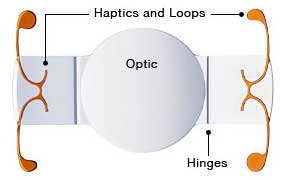
Crystalens is designed to allow the optic, or the central circular part of the lens that you see through, to move back and forth as you constantly change focus on images around you. Crystalens flexes as you focus your vision.
Crystalens® is:
- The first and only FDA-approved accommodating intraocular lens
- The only FDA approved intraocular lens that uses the natural focusing ability of the eye
- The only FDA approved presbyopia correcting IOL for cataract patients that provides a single focal point throughout a continuous range of vision
- Few patients with Crystalens have experienced problems with glare, halos and night vision. crystalens focuses only one image to the back of the eye, unlike a multifocal lens that projects multiple images, requiring your brain to “adjust” to the differences.
- The effectiveness of the Crystalens® was proven in clinical trials:
- Significantly more patients implanted with a Crystalens (88.4%) could see better at all distances then patients implanted with a standard IOL (35.9%)
- Most patients have continued to report excellent vision 7 years after implantation with Crystalens.
- More than 100,000 Crystalens implants have been implanted worldwide, and that number is growing daily.
Crystalens accommodates like the natural lens. After implantation of Crystalens, most patients will see brighter and clearer from distance, intermediate to near like they did when they were younger.
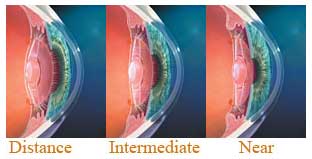
ONLY FDA-Approved accommodating IOL
Crystalens was the first presbyopia correcting IOL introduced into the United States market and is currently the only FDA-approved accommodating IOL. Crystalens addresses the limitations of standard monofocal IOLs and multifocal IOLs by providing the following advantages to patients:
- Provides a Broad Range of Vision: Crystalens moves and changes shape using the eye's natural focusing mechanism, instead of remaining fixed and stationary within the eye. This movement, or accommodation, allows the eye to focus on objects across a broad range of distances to reduce or eliminate dependence on glasses. In particular, this accommodation provides significant advantages in addressing intermediate vision.
- Maintains Clarity of Vision: Unlike multifocal lenses, Crystalens directs all available light received by the eye to a single focal point, comparable to that of a healthy natural lens.
- Patient Adjustment Not Required: Crystalens produces a single image consistent with normal vision, meaning patients do not need to neuroadapt to viewing multiple images. Patients also do not need to tolerate or adjust to high levels of halos and glare often associated with multifocal IOLs.
The Crystalens® Procedure
The Crystalens® procedure is simple and allows for relatively fast healing. After a small incision is made at the edge of the cornea, the lens is liquefied and the crystalens® is implanted. Crystalens® can usually be implanted in about 15 minutes.

The recovery period is usually short. Most patients are able to pursue normal activities almost immediately after surgery. Patients usually have a follow-up visit scheduled with the surgeon to evaluate the patient’s recovery. Discuss with your doctor beforehand what to expect before, during, and after the procedure in terms of eye drops and office visits.
If you are like most patients who have the Crystalens®, you can expect to see everything more clearly. Your focus will be sharper than it has been in years, and you can expect to see improvements over time.
Frequently Asked Questions
Quick facts on cataracts & presbyopia
- Cataract surgery is one of the safest and most common surgeries in the world.
- More than 3 million cataract surgeries are performed every year in the U.S.
- More than 50% of Americans over 65 have developed cataracts in one or both eyes.
- A cataract surgery is performed on average more than 8,000 times a day.
- Everyone who lives long enough will develop cataracts.
- 91% of cataracts are caused by the aging process.
- Most people, usually beginning in their mid forties, start to experience presbyopia (blurred near vision) even if they have had great vision their whole lives. Glasses are typically needed for activities such as reading, sewing, or working at the computer.
Quick facts on Crystalens®
- Patients who are good candidates for standard monofocal IOLs are typically good candidates for Crystalens. If a patient has healthy eyes, has not had previous cataract surgery, and does not suffer from any major health problems then he or she is likely to be a good candidate.
- More than twice the number of patients implanted with Crystalens could see well at all distances compared to a standard IOL.
- Most Crystalens patients have reduced their dependence on glasses and are able to read the newspaper or a phone book without glasses.
- Most Crystalens patients are able to see their computers, dashboards and anything else at arm’s length without glasses.
- Most Crystalens patients are able to see 20/40 or better after surgery, so the clock across the room and the TV in the corner are clearly within sight.
- Many of our Crystalens patients can see well enough to do away with their reading glasses, bifocals, or contact lenses.
- crystalens procedure is highly successful and most people regain very good distance vision, somewhere between 20/20 and 20/40.
Most Frequently Asked Questions
1) What is Crystalens®?
Crystalens is an intraocular lens that, unlike a standard IOL, can treat both a person’s cataracts and a person’s presbyopia (loss of near and intermediate focusing ability). You probably noticed in your forties that you started to lose some of your up-close vision and had to start wearing reading glasses; this was due to a loss of accommodation. crystalens is designed to recreate your accommodation and reduce or eliminate wearing glasses. With the unique crystalens, you can enjoy activities such as: reading a book, working on the computer, and driving a car.
2) How does it work?
Crystalens replaces the eye’s natural lens and is designed to mimic the eye’s natural focusing ability, thereby enabling vision across a broad range of distances comparable to a healthy eye. As with the natural lens, crystalens accommodates, or moves and flexes, in response to ciliary muscle contractions in the eye. These contractions drive forward movements of the lens so the eye can maintain a clear image as it focuses on near, intermediate and far objects.
3) How is this different from regular cataract surgery?
In the past, cataract surgery was only able to treat a patient's cataracts, so patients would still be dependent on glasses for most of their daily activities, especially for up close and intermediate activities. Crystalens will correct for more than just your cataracts. crystalens can offer you a fuller range of vision and reduce or eliminate your dependence on glasses.
4) How do I know if I am a good candidate?
If your eyes are healthy, you have not had previous cataract surgery and you have no major health problems, you may be an excellent candidate for crystalens. Your doctor will perform a thorough exam and advise if Crystalens is right for you.
5) How is Crystalens® different from other lifestyle lenses on the market?
Crystalens is the only accommodating intraocular lens on the United States market. As with the natural lens, Crystalens accommodates, or moves and flexes using an innovative design, in response to ciliary eye muscle contractions. These contractions drive forward movement of the lens as it focuses on near, intermediate and far objects.
6) Can my vision be corrected to 20/20 for both reading and distance?
No surgeon can guarantee 20/20 vision because everybody’s eyes function differently. However, our patients have been reporting excellent results and most enjoy the majority of their activities without glasses.
7) Will I really be able to see without glasses? Will I be 20/20?
Since everyone’s vision, expectations, and lifestyles differ it is difficult to determine how much you will be dependent on glasses. If you are like the majority of crystalens patients, you should be able to experience the same quality vision you did when you were younger, with minimal or no dependence on glasses after crystalens surgery.
8) Will I be able to read in all lighting conditions?
Crystalens works similarly to your natural lens in that it delivers 100% of available light rays at all distances -- near, far, and intermediate. Unlike many mulitfocal IOLs on the market, lighting conditions have very little impact on patients with Crystalens. Crystalens directs all available light received by the eye to a single focal point, resulting in quality of vision comparable to a healthy natural lens. Patients have reported very minimal disturbances. However, it is recommended that you use good lighting when reading.
9) Will I experience halos and glare? Will this lens effect how I drive at night?
All IOLs, including standard monofocal IOLs, can create some degree of halos and glare. Glare and halos have sometimes been observed with the crystalens. However, unlike a multifocal IOL, crystalens works similarly to your natural lens in the way it delivers available light rays at all distances -- near, far, and intermediate. As a result, Crystalens patients typically experience fewer halos and less glare than a multifocal IOL patient.
10) Will insurance/Medicare cover any of the procedure?
Insurance coverage varies greatly from policy to policy. Generally speaking, private insurance and Medicare will cover the cataract surgical procedure and may also allow a certain additional amount for a standard lens implant. With Crystalens, you are receiving an additional benefit of presbyopia correction that will allow you to enjoy a fuller range of vision with decreased dependence on glasses. You will be responsible for paying for the presbyopia correcting portion of the surgery, which is not covered by Medicare.
11) What about my intermediate vision, like working on the computer?
In the Crystalens clinical trials, patients reported good intermediate vision. Most Crystalens patients are able to see their computers, dashboards and anything else at arm’s length without glasses.
12) Will Crystalens® stop working over time?
Crystalens surgery is permanent and there is no evidence that the lens will stop working over time. Patients have had Crystalens implanted in their eyes for nearly 7 years with no change in its ability to flex. It is an extremely well-tested and durable design. In fact, there is clinical evidence to support that most patients' vision continues to improve with time.
Surgery Questions
Every patient is different and only your surgeon can fully explain the details of your Crystalens procedure. However, the following information may be helpful for most patients.
13) Should I have the procedure in both eyes?
Typically cataracts will develop in both eyes, and we recommend that the surgery be done in both eyes. Usually you will have surgery on the second eye within 2 weeks of the first eye.
14) How long will the surgery take?
Cataract surgery is typically an outpatient surgery. The actual surgery itself is approximately 15--20 minutes.
15) Will I feel anything?
No. Topical anesthetic drops will be placed in your eye and oral medications may be administered to help you relax.
16) When will I be able to return to my normal activities?
Typically you will be able to return to normal activities within several days. You should be able to drive and return to work within 2--3 days.
Your eyes may be sensitive to the touch for a few days, and you should avoid strenuous activity and rubbing your eye. It is important to avoid lifting or straining that would increase pressure on your eye.
You can shower, but avoid getting soap in your eyes. Refrain from eye makeup for several weeks. You should also avoid public pools and hot tubs.
17) What should I expect during the recovery period?
Patients vary widely in how they are affected during the recovery phase. For example, for some patients it takes longer for their near vision to come into focus, while others achieve great near vision almost immediately. The best way to learn about the recovery period is to talk to your surgeon about the procedure.
18) How often will I need to have my eyes checked after surgery?
Your doctor will advise you based on your procedure. Typically, the doctor will see you one day after surgery, after 2--4 weeks and again around 3--6 months after surgery. Thereafter, an annual exam is sufficient.
19) Will I have to have cataract surgery again?
Once your cataracts are removed and replaced with an IOL, you will never need to have cataract surgery again. Occasionally, several months after the lens has been placed in the eye, your vision may start to become cloudy again. This can happen with any type of IOL. This is sometimes called a secondary cataract and refers to the clouding of the membrane that surrounds the implant. Your surgeon will go in and quickly remove the clouded cells. This is done painlessly in an out-patient environment and usually takes just a few minutes.
Precision Manufacturing
Quality makes a difference. Crystalens® intraocular lenses have been made carefully, under strict high-quality standards beyond what other companies have used to make their lenses.
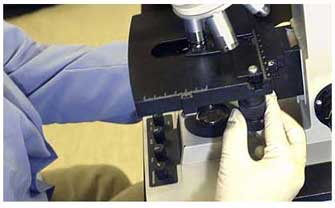
Each Crystalens®:
- Is polished with "polishing beads" which are individually inspected by hand
- Undergoes a 3-step cleaning process
- Is checked for power accuracy
- Is individually inspected before packaging
- Is the only premium lens available in 0.25 diopters, allowing the surgeon to make a precise match with patients needs
This means that both you and your surgeon can be assured that you have a premium quality lens.
Cataracts
A cataract is the clouding of the natural lens. The clouding in the lens disrupts transmission of light through the lens. Vision may be blurred, dark, and distorted.
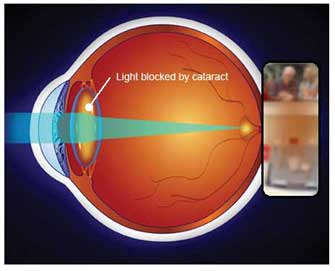
The Aging Eye
In the aging eye the lens loses its ability to change shape and images are out of focus. Reading glasses or bifocals are required to help the eye focus. This condition, which begins to affect most people in their forties, is called presbyopia. Presbyopia is the inability of your eyes to accommodate.

"Dr. Crane is one of less than 100 doctors in the United States to be able to bring this new technology to his patients."
"Dr. Crane is one of less than 100 doctors in the world who have been approved to participate in the iDose FDA trial"
iDose exchange
"Dr. Crane is one of less than 15 doctors in the United States to perform this procedure for his patients."
"Dr. Crane is one of less than 15 doctors in the world who were approved to participate in the iDose exchange FDA trial"
Infinite
"Dr. Crane is one of less than 15 doctors in the United States who were able to bring this new technology to his patients."
"Dr. Crane is one of less than 15 doctors who were approved to participate in the iStent Infinite FDA trial"
General
FDA issues warning for contaminated eye drops that can cause infection.
"Dr. Crane and Glaukos have a long history of working together on several medical device and pharmaceutical studies. He has been able to offer these technologies to his patients and the products from these studies have progressed to help treat hundreds of thousands of patients in need."
Employment Opportunity: Optometrist in Essex, Morris, and Union Counties
Dr. Crane Top Doctor 2019
Congratulations to Dr. Crane for being the 2nd surgeon in the United States to perform a new treatment for Glaucoma. We hope this treatment will bring further advances in the care of our glaucoma.
ASCRS Thanks Dr. Crane for Volunteer Work
Dr. Spier Named to OSN's Premier Surgeon 300
Dr. Spier: Weekend Comedian
Dionne Warwick on Dropless Surgery [VIDEO] (Surgery Performed by Dr. Spier)
Dr. Crane and Staff congratulate their patient Dr. William Scaife
Dr. Crane named to the ASCRS Council of 100
 Dr Crane meets one of his favorite Sharks, Daymond John, at a book signing!
Dr Crane meets one of his favorite Sharks, Daymond John, at a book signing!
